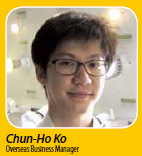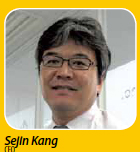Kocom
 Established in 1976, Kocom got its start in audio phones. It branched out into home automation, surveillance, LED lighting and eventually solar power — positioning itself as a provider of home automation and energy solutions. Kocom's CEO once said, “Anyone who purchases Kocom products has to be rich.” Besides clear strategies, Kocom emphasizes product quality and partner relationships.
Established in 1976, Kocom got its start in audio phones. It branched out into home automation, surveillance, LED lighting and eventually solar power — positioning itself as a provider of home automation and energy solutions. Kocom's CEO once said, “Anyone who purchases Kocom products has to be rich.” Besides clear strategies, Kocom emphasizes product quality and partner relationships.
Chun-Ho Ko, Overseas Business Manager, Kocom, points out smartphones and the emergence of a middle class with more education, income and familiarity with technology allow more end users to embrace home automation. While this group represents a fraction of the market, they can attract a large following. However, due to the dominance of single-unit homes in the U.S., widespread deployments will take longer.
Kocom's broad product portfolio targets real estate developers, so it goes to market with the same channel partners for intercoms, home automation, video surveillance, LED lighting and solar products. Its newly launched network camera line is carried through existing partners, but not all of them are able to support network video solutions. To promote its network line, Kocom is open to recruiting new distributors.
When asked about future IP application for security, Ko pointed out that market adoption for network solutions is still in its early stages. Most customers are considering IP but not yet purchasing related solutions. However, it is clear that market is moving toward IP.
Pixelplus
 Pixelplus was established in 2000 as a maker of consumer image sensors, formed by a team of semiconductor and CCD experts. It initially targeted the mobile phone market, but the returns were small in a saturated market.
Pixelplus was established in 2000 as a maker of consumer image sensors, formed by a team of semiconductor and CCD experts. It initially targeted the mobile phone market, but the returns were small in a saturated market.
The company now focuses on security, automobile and medical applications. Its new production process has won business worldwide, creating a market niche. SK Lee, CEO of Pixelplus said the company is among the few component suppliers developing sensors for professional security users. About 60 to 70 percent of sales come from security business.
Unlike mobile phone sensors, which try to cram as many pixels onto a sensor, smaller pixels are unacceptable for security's sensitivity demands. For clear images, pixels on the sensor must be sufficiently large to improve light sensitivity.
Chip design also affects image quality, as analog and digital components can create noise. Noise reduction is crucial for sensitivity and WDR, as automatic gain control will increase image noise as well.
The company develops CMOS image sensors for their low cost with fewer accessories and ease of integration, Lee said. This results in increased reliability. As labor costs increase in China, more production will shift to countries such as India and Brazil. Lee is considering opportunities in these emerging markets for the future.
Young Kook
 Starting in 1979, Young Kook is a leading system integrator in Korea. It specializes in thermal imaging for industrial applications, such as metal production, nuclear plants and military projects.
Starting in 1979, Young Kook is a leading system integrator in Korea. It specializes in thermal imaging for industrial applications, such as metal production, nuclear plants and military projects.
The company developed a 360-degree fisheye dome, which won a product excellence award from the Korean government. It holds patents in more than 20 countries. An outdoor night vision camera can monitor objects from a distance of 70 meters. This solution is suited for education and traffic monitoring.
The Korean market has strong demand for HD, as analog solutions are being replaced. Young Kook also plans to expand overseas, with its specialized product know-how. It is partnering with system integrators for government projects in emerging South Asian countries and China.
HT
 HT provides high-end image sensor processors (ISP). It is a fairly young company, established by semiconductor experts with more than 20 years of experience.
HT provides high-end image sensor processors (ISP). It is a fairly young company, established by semiconductor experts with more than 20 years of experience.
To increase its market share, HT plans to launch midrange and budget solutions. It understands security imaging need for quality footage, regardless of the application or time of day.
HT believes that a good camera should deliver WDR for daytime imaging, along with high resolution with low noise, stable AE, AWB and superb color accuracy. At night, the camera should include DNR, 2-D and 3-D filters and clear low-light capability. HT strives to produce solutions that have strong performance.
Sejin Kang, CEO of HT, explains the differences between WDR solutions. One way is to put WDR on an ISP, while another way is to include it on the image sensor. However, the latter method is not recommended. As higher sensitivity is required for nighttime surveillance, WDR image sensors require more processing resources and could sacrifice sensitivity.
Two of HT's future developments for ISPs include intelligent video analysis and full HD imaging, requiring H.264 encoding with low power consumption, Kang said.